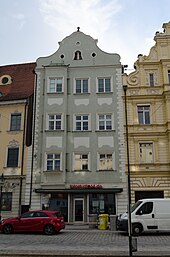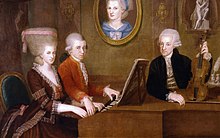Johann Andreas Stein
Johann Andreas Stein (born May 6, 1728 in Heidelsheim , † February 29, 1792 in Augsburg ) was one of the widely acclaimed instrument makers of his time. His pianos were played and praised by Wolfgang Amadé Mozart . The Streicher family continued his achievements in building fortepianos in Vienna and the organ and piano maker Johann Evangelist Schmidt in Salzburg .
Life
Johann Andreas received his first instruction in organ building technology from his father. Like his cousin Georg Marcus Stein , Stein developed this basic knowledge in his apprenticeship with Johann Andreas Silbermann and Johann Heinrich Silbermann in Strasbourg and then worked with the Regensburg master Franz Jakob Späth . After further years of apprenticeship and traveling in Ulm and Stuttgart , he came to Augsburg for the first time in 1750 and took up his permanent residence there the following year. In 1752 the artisan joined the “music lovers and practicing society” of the Augsburg bourgeoisie. In 1757 Stein received town citizenship . The new organ in the Barfüßerkirche, inaugurated at Pentecost in the same year, was supervised by its creator as organist .
Organ builder
In Augsburg there was no longer a master organ builder around 1750 , but a number of organs in the town's houses of worship were in need of repair or some had to be completely renewed, which provided a professional like him with enough livelihood. In 1756, by overhauling the action and in 1767 by adding a new bellows system, he ensured that melodious church music was restored in St. Anna's Church in Fuggerstadt. In 1769 he repaired the musical instrument of the Protestant Ulrichskirche . In 1780 it was the turn of the St. Peter am Perlach organ . The only and overall very well preserved organ of Stein is in the monastery church of St. Thekla in Welden near Augsburg. During the last restoration, a large part of the metal pipes had to be replaced. The occasional information that Stein built an organ in Eichstätt Cathedral is probably based on an error: around 1800 this instrument was equipped with a short octave , which Stein considered to be out of date. Presumably he was just doing a repair.
Piano maker

The employment as organist at the Barfüßerkirche as well as the task of looking after the organs in the Augsburg churches granted Stein a solid basic income. Therefore, he could increasingly turn to the construction of pianos. In this he succeeded in 1773 to improve the "German piano mechanics" which the fortepiano ahead brought a decisive and strong thrust gave the shoulder of the musical instrument.
The fortepiano was invented by the Florentine Bartolomeo Cristofori around 1700 with a pestle mechanism, which initially could not establish itself in this way in the following decades. Johann Andreas Stein succeeded in equipping the bounce mechanism, in which the hammers are mounted directly on the key levers, with a so-called release. This pianoforte became more reliable, more sonorous and more capable of modulation. Leopold Mozart , Wolfgang Amadé Mozart and Ludwig van Beethoven were enthusiastic about the new sound feeling . When Stein's development was taken over by Viennese piano makers, the name "Viennese Mechanics" was created. In addition to making improvements to the pianoforte, Stein also invented other musical instruments. Several times he built so-called vis-a-vis grand pianos, in which a harpsichord and a fortepiano face each other in an instrument body. Two of these instruments have been preserved.
The Mozart family was well acquainted with Johann Andreas Stein. In 1763 Leopold Mozart bought a traveling piano for his son during his stay in Augsburg , which Wolfgang Amadé then played for years. 14 years later, the well-established composer gave a concert in Augsburg in the Fuggerhaus , for which three pianos were provided. The cathedral organist Johann Michael Demmler played on the first, Wolfgang Amadé Mozart on the second and Johann Andreas Stein on the third. Although Wolfgang Amadé expressed his enthusiasm about Stein's instruments in a letter to his father, he never bought a grand piano from Stein himself. In Vienna he mainly played pianos made by Anton Walter , who already had catchers for the hammers bouncing back from the strings, which enabled faster repeating.
In the course of his life, Stein built around 700 pianos in his Augsburg workshop, which were in demand all over Europe. One of Stein's gavel pianos, made in 1785, is kept in the Augsburg Mozart House . In keeping with the fashion of the time, he signed his instruments with the French version of his first name "Jean André Stein".
At the end of the 18th century, stone pianos were among the top products in keyboard instrument making. Previously this applied to harpsichords from the Antwerp Ruckers family , later to English fortepiano from Broadwood , then to the French manufacturers Pleyel and Erard , and since the end of the 19th century to Steinway & Sons . This is why stone pianos are among the icons of historical music performance practice and also among collectors.
progeny
- Nannette Streicher , née Anna-Maria Stein (born January 2, 1769 in Augsburg, † March 16, 1833 in Vienna). She married the pianist and piano maker Johann Andreas Streicher in 1794 and carried on the paternal inheritance together with her brother, then after the siblings separated on business alone or with her husband Andreas Streicher in Vienna.
- Matthäus Andreas Stein (* December 12, 1776 in Augsburg, † May 6, 1842 in Vienna)
- Friedrich Stein (born May 26, 1784 in Augsburg, † March 5, 1809 in Vienna)
List of works (selection)
| year | place | building | image | Manuals | register | Remarks |
|---|---|---|---|---|---|---|
| 1756-1757 | augsburg | Barefoot Church | destroyed in World War II | |||
| 1757 | Obergriesbach | |||||
| 1763 | Welden near Augsburg | Theklakloster | I / P | 8th | original preserved → organ |
|
| 1766 | augsburg | Holy Cross Church |
Piano building dynasty
Johann Andreas Stein's children, Matthäus Andreas and Anna-Maria Stein , called Nannette, took over their father's workshop after his death in 1792. Two years later, however, they moved to Vienna and jointly opened a piano factory there under the name "Frère et Soeur Stein" (German: "Brother and Sister Stein"). In 1802 they parted company. Matthäus Andreas continued his company under the name "André Stein". He was acquainted with Ludwig van Beethoven , whose instruments he also maintained.
Carl Andreas Stein (born September 4, 1797; † August 28, 1863 in Vienna)
Matthäus Andreas' son Carl also learned the piano-making trade. In 1829 he received his license to make piano and in 1841 took over the business of the famous piano maker Conrad Graf in the Mondscheinhaus . In 1844 he received the title of " kuk Hof-Pianoforte manufacturer".
Under the name Streicher, pianos were produced for several generations until it was closed in 1896.
source
- Catalog of the collection of old musical instruments, Part I: String pianos, Vienna: Kunsthistorisches Museum 1966
literature
- Eva Maria Hertz; Johann Andreas Stein (1728–1792). A contribution to the history of piano making ; Wuerzburg 1937.
- Silke Bettermann, Michael Ladenburger; The organ by Johann Andreas Stein in the Barfüßer Church in Augsburg ; in: The Queen of Instruments - Organ engravings from the Beethoven period from the Hans Gerd Klais collection , book accompanying an exhibition in the Beethoven House; Bonn 2000, p. 65; ISBN 3-88188-061-5
- History of the city of Augsburg from Roman times to the present; Stuttgart 1984; ISBN 3-8062-0283-4
- Baedecker Augsburg; Ostfildern-Kemnat 2004; ISBN 3-87954-001-2
- Michael Latcham; Mozart and the pianos of Johann Andreas Stein ; in: "The Galpin Society journal" 51 (1998), pp. 114–153 (English)
Web links
- Biography Johann Andreas Stein
- Fortepiano and modern grand piano ( Memento from September 28, 2007 in the Internet Archive ) (PDF; 357 kB)
Individual evidence
- ↑ […] Now I have to start with the stone piano forte […]; Salzburg, International Mozarteum Foundation: Letter from Wolfgang Amadé Mozart to his father. In: Mozart Letters and Documents - Online Edition, [1] , Augsburg on October 17, 1777.
- ↑ [...] Before I saw anything of the stone of his work, the late clavier was my favorite; (Mozart meant the tangent piano by Franz Jacob Spaeth ). But now I have to give preference to the stone; because they dampen much better than the Regensburg. when I hit hard, I like to leave my finger there or pick it up, the tone is over in the instant when I let it be heard. I like to get to the claves as I want, so the tone will always be the same. he will not shiver, he will not walk stronger, weaker, or even stay away; in a word, it's all the same. [...] his instruments have one thing above all else that they are made with release. the hundredth doesn't bother with it. but without triggering it is simply not possible that a piano forte does not shiver or linger; Your hammers, whom you allude to the claves, fall at the moment when they jump up the strings, down again, you can leave the claves behind or leave them out. when he has finished such a piano (as he told me himself) he first sits down and tries all sorts of passages, run and jump, and scrapes and works until the piano does everything. Because he only works to use the music, and not for his own benefit alone, otherwise he would be finished right away [...]; Salzburg, International Mozarteum Foundation: Letter from Wolfgang Amadé Mozart to his father. In: Mozart Letters and Documents - Online Edition, [2] , Augsburg on October 17, 1777.
| personal data | |
|---|---|
| SURNAME | Stein, Johann Andreas |
| BRIEF DESCRIPTION | German organ and piano builder |
| DATE OF BIRTH | May 6, 1728 |
| PLACE OF BIRTH | Heidelsheim |
| DATE OF DEATH | February 29, 1792 |
| Place of death | augsburg |


